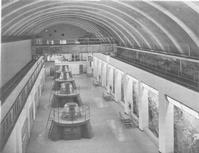


Chapter 11
I The Present Energy Economy
II Australian Energy Consumption
III Research And Development
IV Coal
V Oil And Natural Gas
VI Solar Energy
VII Nuclear Energy
VIII Bagasse Firewood And Other Biomass
IX Electric Power Generation And Distribution electric Power Generation And Distribution
i Types of generating stations
ii Transmission and distribution
iii System load control
iv Australian manufacturing in the power industry
v Queensland
vi New South Wales
vii Victoria
viii Tasmania
ix South Australia
x Western Australia
xi Northern Territory
xii Australian Capital Territory
xiii The Snowy Mountains Scheme
X Manufactured Gas
XI Industrial Process Heat
Sources
Index
Search
Help
Contact us

The Snowy Mountains Scheme
As a result of a parliamentary committee of inquiry set up in 1947, the Snowy Mountains Hydro Electric Authority was created by an Act of that name in 1949. It was chartered to develop the waters of the Snowy Mountains Area for the production of electricity, and to divert water from coastal rivers through trans-mountain tunnels to augment the catchments of the Murray and Murrumbidgee Rivers for additional irrigation purposes.At the outset a Commissioner was appointed in the person of Mr. (later Sir) William Hudson, who at the time was Engineer-in-Chief with the Sydney Water Board. No staff were transferred from other bodies, and Hudson was urged to recruit mainly from overseas to avoid taking skilled personnel away from other post-war reconstruction work. Consequently a cosmopolitan staff and work force was created. During the first 5 years one of the smaller and more straightforward hydro projects was designed and completed, so that 60 MW from Guthega power station flowed into Sydney in February 1955, much to the relief of that power starved city.
A complex Agreement was entered into with the States of NSW and Victoria as to the manner of operating the Scheme, and was incorporated into the Act in 1958 -just prior to the interlinking of the Snowy Scheme with Victoria and hence interconnecting the two State systems for the first time as described above. The long range decisions as to water storages and releases (and other matters) are made by a body styled the Snowy Mountains Council, which comprises representatives of the Commonwealth and of the water and electricity authorities of both States. This Council began work in 1957.
Many problems were encountered with the civil works, which have been described in Chapter 6 and many outstanding innovations arose from the work of the Authority's staff. In the electrical and mechanical field bold decisions were made as to choice of plant, and in unit sizes beyond previous world achievement. A particular case was the selection of Francis turbines for the Murray 1 power station at a high head only once before attempted (in Norway) on much smaller machines. For the last station, Tumut 3, units of 250 MW capacity were chosen in 1965, when no other of such size was in operation worldwide.

Not least of the special problems encountered was that of ice formation on the power lines at the higher altitudes; The climate is such that many oscillations of temperature around freezing point occur, and the terrain provides several locations where wind streams can be forced rapidly upwards and condense ice particles rapidly on any obstruction such as a power line. Fieldwork identified the conditions of such phenomena so that suitable designs and line routing could minimise damage. In particular a special aluminium alloy conductor was developed with a British manufacturer, with excellent results.
Organisations in Australian Science at Work - Snowy Mountains Council; Snowy Mountains Hydroelectric Authority (S.M.H.A.); Snowy Mountains Scheme
People in Bright Sparcs - Hudson, Sir William
 |
Australian Academy of Technological Sciences and Engineering |  |
© 1988 Print Edition page 835, Online Edition 2000
Published by Australian Science and Technology Heritage Centre, using the Web Academic Resource Publisher
http://www.austehc.unimelb.edu.au/tia/814.html